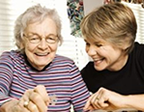renewal cycles. Complete
some now & some later.
and Get 25% off
the Total price!
Buy 3 Courses
and Get 30% off
the Total price!
Buy 4 Courses
and Get 35% off
the Total price!
| Create Account | Login | ||

Section 17
Working Surface Assessment
Table of Contents | NCCAP/NCTRC CE Booklet
When you work with an activity like Caps-in-a-Bowl to facilitate Helen’s independence, you need to place the bowl on something, as opposed to holding it. Often your resident is sitting in a lounge or hallway. You will find that an over-the-bed-table is, in most cases, the easiest most readily available work surface. Bringing the work surface to your resident, rather than the other way around, allots a more efficient use of your time.
The over-the-bed-table needs to be adjusted to a height that is usually at your resident’s elbow height. If it is above his or her elbow, your resident’s arm usually ends up at a 30 degree angle and Helen will have a hard time angling her wrist to do any form of an activity. Adjust the over-the-bed-table, to as low a level as possible, without putting pressure on your resident’s knees. No doubt you have found, as I have, that it takes a little doing to gently and careful get the support legs for the over-the-bed table threaded between, through, and around foot pedals, feet, and perhaps stiff, almost immobile legs. In some cases, you just have to settle for the best positioning you can get regarding the placement of the bed table, so as not to create a negative experience for your resident.
In addition to looking at your Helen’s shoulder height and the angle of her elbow for comfort, you might assess the angle of her forearm as it relates to her wrist. Many residents have very stiff wrists. You might use a pillow to prop her elbow up in order to get her hand at the best angle to the work surface.
The preceding positioning basics regarding adjustment
and provision of a work surface need to be applied to all
Success Therapy® object manipulation activities that require a work surface.
NCCAP/NCTRC CE Booklet
Forward to Section 18
Back to Section 16
Table of Contents
Top


